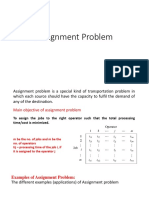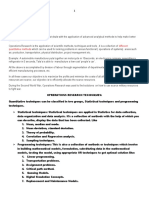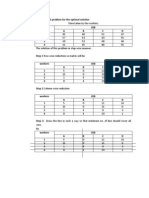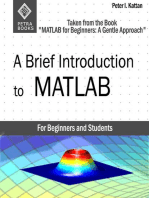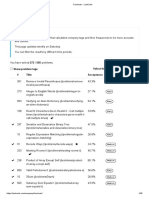Assignment Minimization Example
Uploaded by
husseinAssignment Minimization Example
Uploaded by
husseinMansoura University 4th Year Prod.
Engineering
Faculty of Engineering Analysis of Prod. Systems, (PRE5411)
Prod. & Mech. Design Eng. Dept. Mid-Term Exam, Dec. 2017
Time: 2hr.
Marks: 20
Question 2: Consider the problem of assigning four operators to four machines. The assignment
costs (in dollars per day) are given in the Table below. Operator A cannot be assigned to machine
1; and operator B cannot be assigned to machine 3.
Assignment Machine
cost ($/day) 1 2 3 4
A 10 15 6 15
Operator
B 15 27 8 9
C 6 21 9 12
D 18 21 21 6
a) Formulate the given problem as an LP one.
b) Find the optimal assignment for the problem.
c) Suppose that a fifth machine is made available. Its respective assignment costs (in dollars
per day) to operators A, B, C, and D, are: 6, 6, 3, and 24, respectively. The new machine
will replace an existing one if the replacement can be justified economically. Reformulate
the problem as an assignment model, and then find the optimal solution.
d) Is it economical to replace one of the four existing machines with the fifth one? If so,
which one?
Mid–APS, Dec.17 Page 1 of 6
Answer of Question 2)
Checking for Balance:
∵ number of Machines (4) = number of Operators (4)
∴ The problem is balanced
Since operator A can’t be assigned to machine 1; and operator B can’t be assigned to machine 3, a high
penalty of (M) is assigned to these cells, where ‘M’ is a large number (Table 2-1)
Table 2-1 First Assignment Table – Row Reduction.
Machine Min.
Cost ($)
1 2 3 4 Value
𝐴 𝑀 15 6 15 6
Operator
B 15 27 𝑀 9 9
C 6 21 9 12 6
D 18 21 21 6 6
i) Formulating as a Linear Programming Problem:
Decision Variables:
1, if the 𝑖 𝑡ℎ operator is assigned to the 𝑗 𝑡ℎ machine
𝑥𝑖𝑗 = {
0, otherwise
Constrains:
Row Constrains: Column Constrains:
4 4
∑ 𝑥𝑖𝑗 = 1, 𝑗 = 1, … ,4 ∑ 𝑥𝑖𝑗 = 1, 𝑖 = 1, … ,4
𝑖=1 𝑗=1
𝑥11 + 𝑥12 + 𝑥13 + 𝑥14 = 1 𝑥11 + 𝑥21 + 𝑥31 + 𝑥41 =1
𝑥21 + 𝑥22 + 𝑥23 + 𝑥24 = 1 𝑥12 + 𝑥22 + 𝑥32 + 𝑥42 =1
𝑥31 + 𝑥32 + 𝑥33 + 𝑥34 = 1 𝑥13 + 𝑥23 + 𝑥33 + 𝑥43 =1
𝑥41 + 𝑥42 + 𝑥43 + 𝑥44 = 1 𝑥14 + 𝑥24 + 𝑥34 + 𝑥44 =1
Objective Function:
4 4
Minimize 𝑍 = ∑ ∑ 𝑐𝑖𝑗 𝑥𝑖𝑗
𝑖=1 𝑗=1
= 𝑀𝑥11 + 15𝑥12 + ⋯ + 21𝑥43 + 6𝑥44
Non–negative Variables:
𝑥𝑖,𝑗 ≥ 0 ∀ 𝑖, 𝑗
Mid–APS, Dec.17 Page 2 of 6
ii) The Optimal Assignment:
Row reduction
To reduce the matrix, the minimum element of each row is determined (see the Table 2-1) and then
subtracted from each element in the row. The results are shown in Table 2-2.
Table 2-2 Column Reduction.
Machine
Cost ($)
1 2 3 4
𝐴 𝑀 9 0 9
Operator
B 6 18 𝑀 0
C 0 15 3 6
D 12 15 15 0
Min. Value 0 9 0 0
Column reduction
The minimum element of each column is determined (see the Table 2-2) and then subtracted from each
element in the row. The results are shown in Table 2-3.
Table 2-3 First optimality test.
Machine
Cost ($)
1 2 3 4
𝐴 𝑀 0 0 9
Operator
B 6 9 𝑀 0
C 0 6 3 6
D 12 6 15 0
First Optimality Test (Table 2-2)
In Table 2-3, the minimum number of lines required to cover all the zero values is determined (denoted
𝑥) and then compared to the matrix size (denoted 𝑛).
∵𝑥=3<𝑛=4
∴ An optimal solution hasn’t been reached yet.
The next step is finding the minimum uncovered element in Table 2-2 (𝑘 = 3), then subtracting it
from each uncovered cell and adding it to each twice–covered cell. This produces Table 2-4.
Mid–APS, Dec.17 Page 3 of 6
Table 2-4 Second optimality test.
Machine
Cost ($)
1 2 3 4
𝐴 𝑀 0 0 12
Operator
B 6 6 𝑀 0
C 0 3 0 6
D 12 3 12 0
Second Optimality Test (Table 2-4)
∵𝑥=3<𝑛=4
∴ An optimal solution hasn’t been reached yet.
In Table 2-4 (𝑘 = 3); subtracting 𝑘 from each uncovered cell and adding it to each twice–covered cell
produces Table 2-5.
Table 2-4 Third optimality test.
Machine
Cost ($)
1 2 3 4
𝐴 𝑀 0 0 15
Operator
B 3 3 𝑀 0
C 0 3 0 9
D 9 0 9 0
Third Optimality Test (Table 2-5)
∵𝑥=𝑛=4
∴ An optimal solution has been reached. The optimal allocation is shown in Table 2-6.
Table 2-6 Optimal Allocation Table.
Machine
Cost ($)
1 2 3 4
𝐴 𝑀 0 0 15
Operator
B 3 3 𝑀 0
C 0 3 0 9
D 9 0 9 0
Mid–APS, Dec.17 Page 4 of 6
Based on the allocation in Table 2-6, the optimal assignment of operators to machines and the
associated costs are listed in Table 2-7.
Table 2-7. Optimal Assignment.
Operator A B C D
Σ
Machine M3 M4 M1 M2
Cost ($) 6 9 6 21 $42
iii) Adding a Fifth Machine:
Checking for Balance
∵ number of Operators (4) ≠ number of Machines (5)
∴ The problem is now unbalanced. A dummy row must be added to balance the problem.
Reformulating the problem
The new cost table after adding a fifth machine and a dummy row is shown in Table 2-8.
Table 2-8 New Assignment Table – Row Reduction.
Machine Min.
Cost ($) Value
1 2 3 4 5
𝐴 𝑀 15 6 15 6 6
B 15 27 𝑀 9 6 6
Operator
C 6 21 9 12 3 3
D 18 21 21 6 24 6
dummy 0 0 0 0 0 0
Row reduction
To reduce the matrix, the minimum element of each row is determined (see the Table 2-8) and then
subtracted from each element in the row. The results are shown in Table 2-9.
Column reduction
Since in Table 2-9, each column has at least one zero, then column reduction steps can be skipped.
Table 2-9 First optimality test.
Machine
Cost ($)
1 2 3 4 5
𝐴 𝑀 9 0 9 0
B 9 21 𝑀 3 0
Operator
C 3 18 6 9 0
D 12 15 15 0 18
dummy 0 0 0 0 0
First Optimality Test (Table 2-9)
Mid–APS, Dec.17 Page 5 of 6
∵𝑥=4<𝑛=5
∴ An optimal solution hasn’t been reached yet.
In Table 2-9 (𝑘 = 3); subtracting 𝑘 from each uncovered cell and adding it to each twice–covered cell
produces Table 2-10.
Table 2-10 Second optimality test.
Machine
Cost ($)
1 2 3 4 5
𝐴 𝑀 6 0 6 0
B 6 18 𝑀 0 0
Operator
C 0 15 6 6 0
D 12 15 12 0 15
dummy 0 0 3 0 3
Second Optimality Test (Table 2-4)
∵𝑥=𝑛=5
∴ An optimal solution has been reached. The allocation is shown in Table 2-11.
Table 2-11 New Allocation Table.
Machine
Cost ($)
1 2 3 4 5
𝐴 𝑀 6 0 6 0
B 6 18 𝑀 0 0
Operator
C 0 15 6 6 0
D 12 15 12 0 15
dummy 0 0 3 0 3
Based on the allocation in Table 2-11, the new optimal assignment of operators to machines and the
associated costs is listed in Table 2-12.
Table 2-12. New optimal Assignment.
Operator A B C D dummy
Σ
Machine M3 M5 M1 M4 M2
Cost ($) 6 6 6 6 0 $24
iv) Replacing a Machine:
∵ In the first case (four machines) the total assignment cost was $42 (Table 2-6); and in the second case
the assignment cost is $24 (Table 2-12).
∴ From an economical point of view, it is recommended to add the fifth machine as this will decrease the
total assignment cost by 42 − 24 = $18.
From the Table 2-12, the 5th machine added should replace Machine number 2 (assigned to dummy
machine).
Mid–APS, Dec.17 Page 6 of 6
You might also like
- Analysis of Production Systems Dr MS HusseinNo ratings yetAnalysis of Production Systems Dr MS Hussein253 pages
- Unbalanced Maximization Assignment ProblemNo ratings yetUnbalanced Maximization Assignment Problem9 pages
- Assignment Problem: Ment Problems and TranNo ratings yetAssignment Problem: Ment Problems and Tran64 pages
- The Assignment Problem: Examwise Marks Disrtibution-AssignmentNo ratings yetThe Assignment Problem: Examwise Marks Disrtibution-Assignment59 pages
- Operations Research Rough Working NotesNo ratings yetOperations Research Rough Working Notes46 pages
- A Modified Method For Solving The Unbalanced Assignment ProblemsNo ratings yetA Modified Method For Solving The Unbalanced Assignment Problems7 pages
- Operations Research - Lecture Twelve - Assignment ModelsNo ratings yetOperations Research - Lecture Twelve - Assignment Models7 pages
- Assignmentproblem 141030113543 Conversion Gate01No ratings yetAssignmentproblem 141030113543 Conversion Gate0134 pages
- XII - Practical No 14. Assignment ProblemsNo ratings yetXII - Practical No 14. Assignment Problems8 pages
- Workers/Machine Jobs: Assignment ProblemsNo ratings yetWorkers/Machine Jobs: Assignment Problems6 pages
- 9 4b Assignment Model Introduction and Simple Problems Ma5UouiPtkNo ratings yet9 4b Assignment Model Introduction and Simple Problems Ma5UouiPtk10 pages
- The Assignment Problems: Learning ObjectivesNo ratings yetThe Assignment Problems: Learning Objectives18 pages
- New Approach To Solve Assignment Problem Using MATLAB: Dr. Jihane KHODERNo ratings yetNew Approach To Solve Assignment Problem Using MATLAB: Dr. Jihane KHODER13 pages
- International Institute of Professional Studies: Presentation On Assignment ProblemNo ratings yetInternational Institute of Professional Studies: Presentation On Assignment Problem13 pages
- Assignment Problems Assignment Problems: Prasun Das Prasun DasNo ratings yetAssignment Problems Assignment Problems: Prasun Das Prasun Das16 pages
- Assignment Problem in Operational ResearchNo ratings yetAssignment Problem in Operational Research4 pages
- Unit 9 - Transportation and Assignment ProblemNo ratings yetUnit 9 - Transportation and Assignment Problem55 pages
- A Brief Introduction to MATLAB: Taken From the Book "MATLAB for Beginners: A Gentle Approach"From EverandA Brief Introduction to MATLAB: Taken From the Book "MATLAB for Beginners: A Gentle Approach"2.5/5 (2)
- 7SENG010C -Data Structures and Algorithms (IIT Sri Lanka) 2024-25vNo ratings yet7SENG010C -Data Structures and Algorithms (IIT Sri Lanka) 2024-25v5 pages
- Mathematical Problems in Engineering - 2023 - Wang - Minimum Spanning Tree Method for Sparse GraphsNo ratings yetMathematical Problems in Engineering - 2023 - Wang - Minimum Spanning Tree Method for Sparse Graphs6 pages
- Reverse Delete Algorithm For Minimum Spanning TreeNo ratings yetReverse Delete Algorithm For Minimum Spanning Tree3 pages
- The Assignment Problem: Examwise Marks Disrtibution-AssignmentThe Assignment Problem: Examwise Marks Disrtibution-Assignment
- A Modified Method For Solving The Unbalanced Assignment ProblemsA Modified Method For Solving The Unbalanced Assignment Problems
- Operations Research - Lecture Twelve - Assignment ModelsOperations Research - Lecture Twelve - Assignment Models
- 9 4b Assignment Model Introduction and Simple Problems Ma5UouiPtk9 4b Assignment Model Introduction and Simple Problems Ma5UouiPtk
- New Approach To Solve Assignment Problem Using MATLAB: Dr. Jihane KHODERNew Approach To Solve Assignment Problem Using MATLAB: Dr. Jihane KHODER
- International Institute of Professional Studies: Presentation On Assignment ProblemInternational Institute of Professional Studies: Presentation On Assignment Problem
- Assignment Problems Assignment Problems: Prasun Das Prasun DasAssignment Problems Assignment Problems: Prasun Das Prasun Das
- Linear Programming and Resource Allocation ModelingFrom EverandLinear Programming and Resource Allocation Modeling
- A Brief Introduction to MATLAB: Taken From the Book "MATLAB for Beginners: A Gentle Approach"From EverandA Brief Introduction to MATLAB: Taken From the Book "MATLAB for Beginners: A Gentle Approach"
- 7SENG010C -Data Structures and Algorithms (IIT Sri Lanka) 2024-25v7SENG010C -Data Structures and Algorithms (IIT Sri Lanka) 2024-25v
- Mathematical Problems in Engineering - 2023 - Wang - Minimum Spanning Tree Method for Sparse GraphsMathematical Problems in Engineering - 2023 - Wang - Minimum Spanning Tree Method for Sparse Graphs
- Reverse Delete Algorithm For Minimum Spanning TreeReverse Delete Algorithm For Minimum Spanning Tree
















